
Characiformes is an order of ray-finned fish, comprising the characins and their allies. Grouped in 18 recognized families, more than 2000 different species are described, including the well-known piranha and tetras.
Tigerfish can refer to fish from various families, and derives from official and colloquial associations of these with the tiger. However, the primary species designated by the name "tigerfish" are African and belong to the family Alestidae.
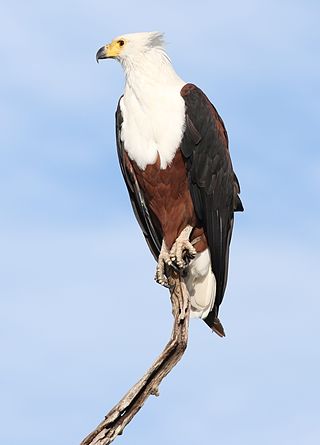
The African fish eagle or the African sea eagle is a large species of eagle found throughout sub-Saharan Africa wherever large bodies of open water with an abundant food supply occur. It is the national bird of Malawi, Namibia, Zambia, and Zimbabwe. As a result of its large range, it is known in many languages. Examples of names include: Vis Arend in Afrikaans, nkwazi in Chewa, aigle pêcheur in French, hungwe in Shona, inkwazi in isiZulu, and ntšhu in Northern Sotho. This species may resemble the bald eagle in appearance; though related, the two species occur on different continents, with the bald eagle being resident in North America.

Bubble nests, also called foam nests, are created by some fish and frog species as floating masses of bubbles blown with an oral secretion, saliva bubbles, and occasionally aquatic plants. Fish that build and guard bubble nests are known as aphrophils. Aphrophils include gouramis and the synbranchid eel Monopterus alba in Asia, Microctenopoma (Anabantidae), Polycentropsis (Nandidae), and Hepsetus odoe in Africa, and callichthyines and the electric eel in South America. Most, if not all, fish that construct floating bubble nests live in tropical, oxygen-depleted standing waters. Osphronemidae, containing the Bettas and Gouramies, are the most commonly recognized family of bubble nest makers, though some members of that family mouthbrood instead. The nests are constructed as a place for fertilized eggs to be deposited while incubating and guarded by one or both parents until the fry hatch.
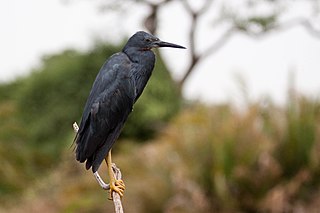
The slaty egret is a small, dark egret found in southern Africa. It is one of the species to which the Agreement on the Conservation of African-Eurasian Migratory Waterbirds (AEWA) applies. It is classified as Vulnerable, the biggest threat being habitat loss.

Pelvicachromis pulcher is a freshwater fish of the cichlid family, endemic to Nigeria and Cameroon. It is popular amongst aquarium hobbyists, and is most commonly sold under the name kribensis, although it has other common names, including various derivatives and color morphs of the kribensis: krib, common krib, red krib, super-red krib and rainbow krib, along with rainbow cichlid and purple cichlid.

Hepsetus odoe, the African pike characin, is a predatory freshwater characin belonging to the family Hepsetidae. It was formerly considered that there was a single species of Hepsetus pike characin but recent studies have led to the species being split and Hepsetus odoesensu stricto is the west African representative of the group.
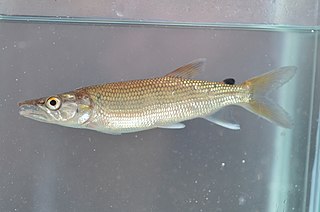
Hepsetus is a genus of African fishes, the African pikes or African pike characins, in the order Characiformes. It is the sole genus in the family Hepsetidae. It was long believed that only a single widespread species existed, H. odoe, but studies in 2011–2013 have shown that this species is restricted to parts of West and Central Africa. The well-known species of southern Africa, including Kafue River, is Hepsetus cuvieri. These predatory fish reach up to 44 cm (17 in) in length.

Hydrocynus is a genus of large characin fish in the family Alestidae commonly called "tigerfish," native to the African continent. The genus name is derived from Ancient Greek ὕδωρ ("water") + κύων ("dog"). The genus contains five species, all popularly known as "African tigerfish" for their fierce predatory behaviour and other characteristics that make them excellent game fish. Hydrocynus are normally piscivorous, but H. vittatus is proven to prey on birds in flight.
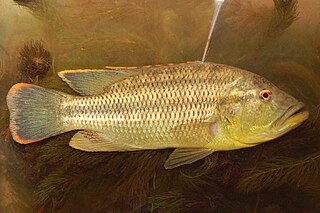
Serranochromis is a genus of relatively large, robust cichlids from freshwater habitats in mainland Southern Africa, ranging as far north as DR Congo and Tanzania, with the highest species richness in the upper Zambezi, Okavango and Congo basins. They are typically known as largemouths or, especially among fishers, breams. Serranochromis are mostly piscivores and they are important in local fisheries.

Hydrocynus goliath, also known as the goliath tigerfish, giant tigerfish, or mbenga, is a very large African predatory freshwater fish of the family Alestidae.

Ctenopoma multispine, known as the many-spined ctenopoma or climbing perch, is an African freshwater fish. It is up to 14 cm (5.5 in) long and occurs in the Lufira River, Lualaba River, Upemba River, Luapula-Moero in the Democratic Republic of the Congo, Upper Zambezi in Zambia and Okavango River-Lake Ngami in Angola and Botswana. It is also known from the Kafue, rivers of coastal Mozambique, Cuanza River in Angola, and southern tributaries of the Congo River system.
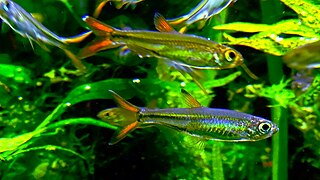
Ladigesia roloffi, the Sierra Leone dwarf characin, is a species of harmless African tetra that is found in Sierra Leone and Liberia, Africa. L. roloffi is the only member of its genus. The fish was named in honor of German aquarist Erhard Roloff (1903–1980), who collected the type specimen. They are a social species generally living in schools at mid depths and surface level fresh water. It lives for five years. Ninety-seven percent of their natural habitat has been lost.

Hydrolycus is a genus of large dogtooth characins from tropical South America, where found in the Amazon and Orinoco basins, as well as rivers of the Guianas. The genus includes the largest dogtooth characins, reaching up to 1.17 m (3.8 ft) in length. They have long, pointed teeth used for spearing their prey, generally smaller fish. In a study of the stomachs of 45 individuals, most were empty, but among the remaining the prey fish were 15–50% of the length Hydrolycus itself.

Hydrocynus vittatus, the African tigerfish, tiervis or ngwesh is a predatory freshwater fish distributed throughout much of Africa. This fish is generally a piscivore but it has been observed leaping out of the water and catching barn swallows in flight.

Hydrocynus tanzaniae, the blue tigerfish, is a large African predatory freshwater fish.

Pseudocrenilabrus philander or the southern mouth-brooder is a small species of haplochromine cichlid found in southern and central Africa. It was first described by the German-Dutch zoologist Max Carl Wilhelm Weber in 1897.
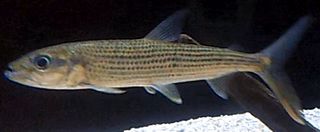
Hydrocynus forskahlii, the elongate tigerfish, is a species of predatory characin from the family Alestidae which is found in northern and western Africa.

Zambezi bream, also known as dwarf bream, is a species of haplochromine cichlid which is found in river systems in southern Africa.

Boulengerella cuiveri, commonly known as the bicuda, is a species of pike-characin in the family Ctenoluciidae.




















